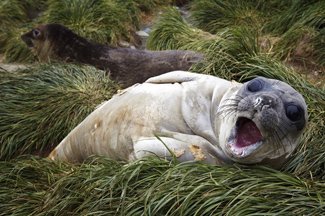Antarctica expedition: Macquarie Island

AG designer Mike Rossi set sail on the AG Society expedition to Antarctica and the sub-Antartic islands.
SIR DOUGLAS MAWSON WAS onto something when he described Macquarie Island as “one of the wonder spots of the world…the great focus of the seal and bird life in the Australasian sub-Antarctic regions”. The Island was World Heritage-listed in 1997 because of its unique geology – an isolated 35 km sliver of oceanic sea bed squeezed up above the ocean surface by tectonic pressure – although it is the wildlife encounters that leave me breathless.
It’s peak hour on Macquarie Island – walking amongst the thousands of inquisitive royal penguins (Eudyptes schlegeli) and majestic king penguins (Aptenodytes patagonicus) who commute to this black sand beach to breed, nest and moult is truly awe inspiring. Being without natural land predators, the birds have no fear of humans, and will happily waddle right up to you if you sit still for a couple of minutes. The beach is also dotted with the snoozing bodies of young elephant seals (Mirounga leonina), hundreds of moulting juveniles and adorable 2 month old weaner pups, who play fight with each other at the water’s edge. To be in such close proximity to these wild, beautiful creatures in such vast numbers makes for a truly magical, unforgettable day.
During the busier summer months, the ANARE base on Macquarie Island is home to about 40 people, including tradespeople, scientists, researchers, meteorologists, wildlife rangers, communication officers, a doctor and a chef. Most are stationed for a period of 12 months, and come and go with the supply ship Aurora Australis that visits the island each April.
The base itself is diesel powered, and has accommodation, a mess hall, a refrigerated food store, a workshop, a satellite communication system, a spa and sauna, a post office (mail gets delivered once a year), a small hydroponic garden and even its own brewery with a capacity of producing 250 bottles of home brew a week!
We are given a tour around the ANARE base by Ivor Harris, the station leader. He tells us that “Most of the people who come down here find it pretty addictive….the environment’s pretty addictive and the lifestyle is pretty good, and people like it and want to come back for more”.
Dean Miller, who spent two summers on the island monitoring fur seal populations, explains the appeal: “You strip life back to bare metal. You take away TV, radio, advertising, traffic jams, mobile phones…and what becomes important is human connection, and connection with nature. And nowhere else on earth do you get that more than on Macquarie Island?”
Along with ongoing weather monitoring and wildlife research, much of the current focus at the base is on the upcoming the rodent eradication program scheduled for winter 2011. The plan is to poison-bait the entire island to rid it of its rat, mouse and rabbit populations that have wreaked havoc on the island’s native vegetation and wildlife.
The initial baiting will be followed up by dog hunting teams. Once the rodents have been eradicated, it is hoped that native vegetation like the Macquarie Island cabbage (Stilbocarpa polaris) and tussock grass will recover, and in turn reduce soil erosion and the incidence of landslides that have been affecting seabird nests and penguin colonies.
See more AG Antarctica expedition blogs.
RELATED STORIES



